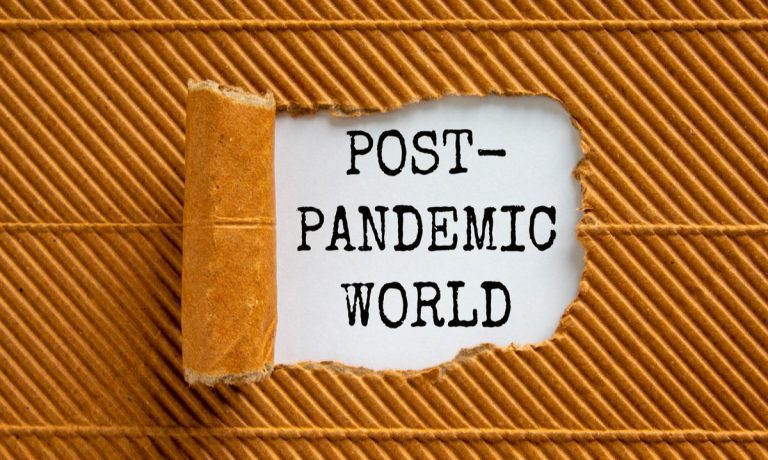
Transport yourself back to April 2020. A national emergency had been declared on March 11, and the lockdowns started soon afterward. Employees in the millions were bemused by orders to work from home. Panic shopping for cleaning supplies and personal protective equipment (PPE) was kicking in. The first emergency-use vaccine was still nine months away.
Major cities were commandeering public parks and filling them with temporary medical centers to handle hospital overflow. Ventilators were in short supply — an alarming addendum.
It was then that PYMNTS began chronicling the COVID-19 pandemic in a series of reports we dubbed “pandenomics” — a mashup of “pandemic” and “economics” — capturing the effects of what would, over the coming months, morph from a health crisis to a world-changing event on par in many ways with a world war, and in other ways unlike anything we’d ever experienced.
What follows is a collection of quotes and statistics taken from that report series, showing just how far we’ve come — and suggesting how far there is to go — in the pandemic recovery.
April 2020: The Post-Pandemic Reset
That we were using phraseology like “post-pandemic” in April 2020 shows how little the world truly understood about what was transpiring, or how long it would last.
Of the many telling statistics in this report, one is eerily similar to where things stand almost two years later with the omicron variant.
As the April 2020 survey said, people are “less concerned that they might infect others and more concerned that they might die. The share of consumers who cite infecting others as their primary concern has decreased steadily from 37.2% on March 17 to 31.4% on April 11. Meanwhile, an increased portion cited a fear of dying, with the share who reported this as their main concern increasing from 25.2% on March 17 to 31.1% on April 11.”
October 2020: The Emerging Post-COVID-19 Consumer
About eight months into what we first saw as a health scare that would come and go like a bad flu season, there were still no vaccines available, delivery aggregators were settling in as the nation’s new kitchen/restaurant go-to combo, and people were resigned to lockdown life.
Per this report, “Our research consistently shows that as the pandemic lasts longer, consumers believe more time will pass before their lives return to normal. The average consumer now believes it will take 374 days before the pandemic’s impact on their lives subsides. This is approximately 2.7 times as long as they expected back on March 17.”
May 2021: After Vaccines — What Mass Vaccinations Mean for Main Street Merchants
By May 2021, vaccines had been in circulation for about five months, so we sampled Main Street small and medium businesses (SMBs) and found the digital shift hard at work.
“The adoption of innovation strategies has become commonplace, with an overwhelming 88% of Main Street SMB owners saying they implemented some type of innovation, such as touchless technology and digitization, during the pandemic,” the May 2021 report states. “Main Street SMBs in the technology sector lead on these investments, with 96% reporting that they implemented innovation strategies during the pandemic.”
PYMNTS found that “Main Street SMBs optimistic about the vaccination rollout are most likely to make investments, with 62% of those that believe vaccination will be ‘very’ or ‘extremely’ successful planning to do so. This share is just 24% among Main Street SMBs that are pessimistic about the vaccine’s effectiveness.”
September 2021: The Post-Pandemic Consumer at 18 Months: Spending Now, Worrying Later
What a difference a year and a half makes. Recall that fear of dying was foremost on consumers’ minds in April 2020. By Q3 2021, money fears had displaced morbidity.
Noting that “consumers are now more worried about how the pandemic will impact the economy than how it will impact their health,” nearly 30% of respondents to this Pandenomics survey cited economic concerns as their big worry, not catching (or dying from) COVID.
“Consumers’ pandemic fears have changed a great deal since the initial outbreak,” the report stated, noting that 62% of all consumers were “very” or “extremely” worried about the pandemic’s ongoing impact on the U.S. economy. “This compares to 48% of consumers who report feeling ‘very’ or ‘extremely’ concerned about how the pandemic might impact their health. Social concerns are third on consumers’ minds, with 44% saying they are ‘very’ or ‘extremely’ concerned about the pandemic’s impact on their social lives.”
With the omicron variant now throwing a wrench into planning once again, the digital transformation of everyday life is so advanced that we ended the year talking a lot about the metaverse — at least one “place” we know of where COVID will never be a concern.
See also: What Consumers Say About the Reopening of the Physical World – and What It Means for Business